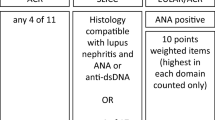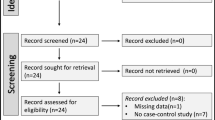Summary
Among 38 human hybridoma-derived monoclonal rheumatoid factors (RFs) generated from patients with either rheumatoid arthritis (RA) or systemic lupus erythematosus (SLE), two groups of RFs can be identified. Monospecific RFs were derived primarily from patients with RA and are characterized by a binding specificity for IgG3 and/or IgG4. Polyreactive RFs were derived largely from patients with SLE and show a broader pattern of reactivity to all four isotypes of IgG. Neither population of RFs was exclusive to either disease. The binding specificities identified appear to be different from the RFs isolated from patients with mixed cryoglobulinemia and may reflect a different antigen selection mechanism.
Similar content being viewed by others
References
Fye KH, Mountsopoulos HM, Talal N (1978) In: Fudenberg HH, Stites DP, Wells JV (eds) Basic and clinical immunology, 2nd edn. Lange Medical Publications, Los Altos
Kunkel HG, Agnello V, Joslin FG, Winchester RJ, Capra JD (1973) Cross-idiotypic specificity among monoclonal IgM proteins with anti-γ-globulin activity. J Exp Med 137:331–342
Chen PP, Goni F, Houghten RA et al. (1985) Characterization of human rheumatoid factors with seven antiidiotypes induced by synthetic hypervariable region peptides. J Exp Med 162:487–500
Newkirk MM, Mageed RA, Jefferis R, Chen PP, Capra JD (1987) Complete amino acid sequences of variable regions of two human IgM rheumatoid factors, BOR and KAS of the Wa idiotypic family, reveal restricted use of heavy and light chain variable and joining region gene segments. J Exp Med 166:550–564
Capra JD, Kehoe JM, Winchester RJ, Kunkel HG (1971) Structure-function relationships among anti-gamma globulin antibodies. Ann NY Acad Sci 190:371–381
Sasso EH, Barber CV, Nardella FA, Yount WJ, Mannik M (1988) Antigenic specificities of human monoclonal and polyclonal IgM rheumatoid factors. J Immunol 140:3098–3107
Köhler G, Milstein C, (1975) Continuous cultures of fused cells secreting antibody of predefined specificity. Nature 256:495–497
Artandi SE, Canfield SM, Tao M-H, Calame KL, Morrison SL, Bonagura VR (1991) Molecular analysis of IgM rheumatoid factor binding to chimeric IgG. J Immunol 146:603–610
Allen JC, Kunkel HG (1966) Hidden rheumatoid factors with specificity for native gamma globulins. Arthritis Rheum 9:758–763
Rauch J, Tannenbaum H, Straaton K, Massicotte H, Wild J (1986) Human-human hybridoma autoantibodies with both anti-DNA and rheumatoid factor activities. J Clin Invest 77:106–112
Randen I, Thompson KM, Natvig JB, Forre O, Waalen K (1989) Human monoclonal rheumatoid factors derived from the polyclonal repertoire of rheumatoid synovial tissue: production and characterization. Clin Exp Immunol 78:13–18
Brown CMS, Plater-Zyberk C, Mageed RA, Jefferis R, Maini RN (1990) Analysis of immunoglobulins secreted by hybridomas derived from rheumatoid synovia. Clin Exp Immunol 80:366–372
Robbins DL, Kenny TP, Coloma MJ, et al. (1990) Serologic and molecular characterization of a human monoclonal rheumatoid factor derived from rheumatoid synovial cells. Arthritis Rheum 33:1188–1195
Thompson KM, Randen I, Natvig JB, et al. (1990) Human monoclonal rheumatoid factors derived from the polyclonal repertoire of rheumatoid synovial tissue: incidence of cross-reactive idiotypes and expression of VH and VK subgroups Eur J Immunol 20:863–868
Newkirk MM, Lemmo A, Rauch J (1990) Importance of the IgC isotype, not the state of glycosylation, in determining human rheumatoid factor binding. Arthritis Rheum 33:800–809
Ezaki I, Kanda H, Sakai K, et al. (1991) Restricted diversity of the variable region nucleotide sequences of the heavy and light chains of a human rheumatoid factor. Arthritis Rheum 34:343–350
Ropes MW, Bennett GA, Cobb S, Jocox R, Jessar RA (1958) 1958 revision of diagnostic criteria for rheumatoid arthritis. Bull Rheum Dis 9:175–176
Tan EM, Cohen AS, Fries JF, et al. (1982) The 1982 revised criteria for the classification of systemic lupus erythematosus. Arthritis Rheum 25:1271–1277
Massicotte H, Rauch J, Shoenfeld Y, Tannenbaum H (1984) Influence of fusion cell ratio and cell plating density on production of human-human hybridomas secreting anti-DNA autoantibodies from patients with systemic lupus erythematosus. Hybridoma 3:215–222
Newkirk MM, Rauch J, Mageed RAK, Jefferis R, Posnett DN, Silverman GJ (1993) Restricted immunoglobulin variable region gene usage by hybridoma rheumatoid factors from patients with systemic lupus erythematosus and rheumatoid arthritis. Mol Immunol 30:255–263
Rauch J, Massicotte H, Tannenbaum H (1985) Hybridoma anti-DNA autoantibodies from patients with rheumatoid arthritis and systemic lupus erythematosus demonstrate similar nucleic acid binding characteristics. J Immunol 134:180–186
Rauch J, Meng Q-H, Tannenbaum H (1987) Lupus anticoagulant and antiplatelet properties of human hybridoma autoantibodies. J Immunol 139:2598–2604
Senécal J-L, Rauch J (1988) Hybridoma lupus autoantibodies can bind major cytoskeletal filaments in the absence of DNA-binding activity. Arthritis Rheum 31:864–875
Hoffman WL, Goldberg MS, Smiley JD (1982) Immunoglobulin G3 subclass production by rheumatoid synovial tissue cultures. J Clin Invest 69:136–144
Paslay JW, Roozen KJ (1982) In: Hammerling GJ, Hammerling U, Kearney JF (eds) Monoclonal antibodies and T cell hybridomas. Elsevier/North-Holland, New York, p 551
James K, Bell GT (1987) Human monoclonal antibody production. Current and future prospects. J Immunol Methods 100:5–40
Borrebaeck CAK (1989) Strategy for the production of human monoclonal antibodies using in vitro activated B cells. J Immunol Methods 123:157–165
Talal N, Roman S, Levinson AI (1990) In vitro secretion of human IgM rheumatoid factor. Evidence for distinct rheumatoid factor. Evidence for distinct rheumatoid factor populations in health and disease. Arthritis Rheum 33:1340–1346
Tarkowski A, Czerkinsky C, Nilsson LA (1985) Simultaneous induction of rheumatoid factor-and antigen-specific antibodysecreting cells during the secondary immune response in man. Clin Exp Immunol 61:379–387
Hirohata S, Inoue T, Miyamoto T (1990) Frequency analysis of human peripheral blood B cells producing IgM-rheumatoid factor. Differential effects of stimulating with monoclonal antibodies to CD3 and Staphylococcus aureus. J Immunol 145:1681–1686
Pasquali J-L, Fong S, Tsoukas CD, Slovin SF, Vaughan JH, Carson DA (1981) Different populations of rheumatoid factor idiotypes induced by two polyclonal B cell activators, pokeweed mitogen and Epstein-Barr virus. Clin Immunol Immunopathol 21:184–189
Martinez-Maza O, Britton S (1983) Frequencies of the separate human B cell subsets activatable to Ig secretion by Epstein-Barr virus and pokeweed mitogen. J Exp Med 157:1808–1814
Chan MA, Stein LD, Dosch H-M, Sigal NH (1986) Heterogeneity of EBV-transformable human B lymphocyte populations. J Immunol 136:106–112
Crain MJ, Sanders SK, Butler JL, Cooper MD (1989) Epstein-Barr virus preferentially induces proliferation of primed B cells. J Immunol 143:1543–1548
Miyawaki T, Butler JL, Radbruch A, Gartland GL, Cooper MD (1991) Isotype commitment of human B cells that are transformed by Epstein-Barr virus. Eur J Immunol 21:215–220
Yarchoan R, Tosato G, Blaese RM, Sinon RM, Nelson DL (1983) Limiting dilution analysis on Epstein-Barr virus-induced immunoglobulin production by human B cells. J Exp Med 157:1–14
Vischer TL, Werner-Favre CF, Wen L, Zubler RH (1988) Quantitative analysis of precursor frequency of rheumatoid factor (RF) producing human B cells. Scand J Rheumatol Suppl 75:123–126
Fong S, Miller JJ III, Moore TL, Tsoukas CD, Vaughan JH, Carson DA (1982) Frequencies of Epstein-Barr virus inducible IgM anti-IgG B lymphocytes in normal children and children with juvenile rheumatoid arthritis. Arthritis Rheum 25:959–965
Munthe E, Natvig JB (1972) Immunoglobulin classes, subclasses and complexes of IgG rheumatoid factor in rheumatoid plasma cells. Clin Exp Immunol 12:55–70
Haber PL, Kubagawa H, Koopman WJ (1985) Immunoglobulin subclass distribution of synovial plasma cells in rheumatoid arthritis determined by use of monoclonal anti-subclass antibodies. Clin Immunol Immunopathol 35:346–351
Mellbye OJ, Vartdal F, Pahle J, Moones TE (1990) IgG and IgA subclass distribution of total immunoglobulin and rheumatoid factors in rheumatoid tissue plasma cells. Scand J Rheumatol 19:333–340
Baccala R, Vo Quang T, Gilbert M, Ternynck T, Avrameas S (1989) Two murine polyreactive antibodies are encoded by non mutated germ-line genes. Proc Natl Acad Sci USA 86:4624–4628
Seigneurin JM, Guilbert B, Bougeat MJ, Avrameas S (1988) Polyspecific natural antibodies and autoantibodies secreted by human lymphocytes immortalized with Epstein-Barr virus. Blood 71:581–585
Lydyard PM, Quartey-Papafio R, Bröker B, et al. (1990) The antibody repertoire of early human B cells. I. High frequency of autoreactivity and polyreactivity. Scand J Immunol 31:33–43
Guigou V, Guilbert B, Moinier D, et al. (1991) Ig repertoire of human polyspecific antibodies and B cell ontogeny. J Immunol 146:1368–1374
Watson WC, Dremer MA, Wooley PH, Townes AS (1986) Assessment of the potential pathogenicity of type II collagen autoantibodies in patients with rheumatoid arthritis. Arthritis Rheum 29:1316–1321
Robbins DL, Benisek WF, Benjamini E, Wistar R Jr (1987) Differential reactivity of rheumatoid synovial cells and serum rheumatoid factors to human immunoglobulin G subclasses 1 and 3 and their CH3 domains in rheumatoid arthritis. Arthritis Rheum 30:489–497
Roitt IM (1988) Essential immunology, 6th edn. Gower Medical Publishing, London, p 44
Shakib F, Stanworth DR (1976) IgG subclass composition of rheumatoid arthritic sera and joint fluids. Ann Rheum Dis 35:263–266
Author information
Authors and Affiliations
Rights and permissions
About this article
Cite this article
Newkirk, M.M., Rauch, J. Monospecific but not polyreactive human hybridoma rheumatoid factors exhibit preferential binding specificities for IgG3 and IgG4. Rheumatol Int 13, 203–209 (1994). https://doi.org/10.1007/BF00390268
Issue Date:
DOI: https://doi.org/10.1007/BF00390268




